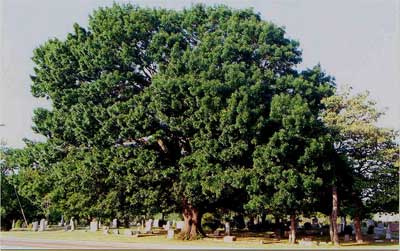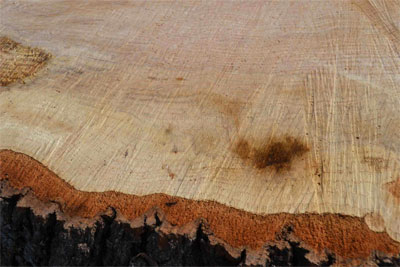Texas Tree Tips – December, 2011
Community Is Saddened by Loss of Champion Red Oak
Cemeteries are where we go to remember and celebrate the lives of our loved ones. In Garland, however, the local community recently visited the Garland Memorial Cemetery to mourn the loss of a majestic Shumard Red Oak. The tree, located along South Garland Avenue, was considered a community landmark. During its prime, the oak stood over 70 feet tall with a crown spread of more than 90 feet and a trunk circumference of 18 feet.

In 1995, the Garland Cemetery Red Oak was recognized as a Metroplex Champion by the Texas Forest Service. Photos courtesy of Arborilogical Services.
In April of 1999, the Shumard Red Oak was recognized by the Texas Forest Service as a Metroplex champion tree — the largest of its species in the area. Steve Houser spoke for everyone at Arborilogical Services who cared for the tree when he said, “It was a living witness to all that occurred in this area. It’s such a significant and sad loss. There’s no other way to describe it.” The tree had also been formally recognized as a historic tree by the Dallas Historic Tree Coalition.
The tree’s troubles began five years ago with the discovery of Ganoderma lucidum, a deadly fungal pathogen, along the tree’s root flare. The tree was extensively cabled to provide supplemental structural support, and an intensive deep root fertilization program was implemented to maintain its health and hopefully extend its life.
This year’s drought and extreme temperatures severely weakened the already stressed tree, and it became infected with hypoxylon canker, another opportunistic pathogen. The tree began to decline rapidly and posed a serious safety risk to visitors in the cemetery as well as to the traffic along South Garland Avenue.
“It was absolutely heartbreaking to lose it,” said Cecil Williams, president of the Garland-Mills Cemetery Foundation, which cares for the cemetery’s trees. The foundation received over 250 phone calls from citizens when they noticed the crews removing the tree. But the tree had become perilous and Williams added, “We could not have it injure or kill anyone. It’s huge, and it had cracked limbs that were leaning over toward Garland Road.”
During the removal process, hundreds of citizens visited the cemetery to watch the crews work and to mourn the loss of the tree. The outpouring of grief over the tree’s loss by the community was astonishing. Everyone had a story about the tree — from admiring it during their daily commute, to parents bringing their children to climb the tree they once climbed themselves. People who no longer live in the area heard about the tree on the local news and drove across town for a last visit and photographs. Local woodworking societies were contacted to preserve suitable wood, and tree cookies were given to visitors wanting mementos.
(Note that Neil Sperry has a lovely piece of the wood and will be turning pens from this tree as soon as it can be dried and stabilized so that he can put them on the lathe.)

Since its removal, The Cemetery Oak’s mammoth stump serves as its own marker.

The Cemetery Oak’s growth rings are currently easy to distinguish.
The mammoth stump now serves as the tree’s own headstone. Visitors can count the rings as a memorial to the life of the tree. The view along South Garland Avenue is forever changed, and the tree that stood witness to Garland’s history for over 125 years has left an empty place in our local landscape and in our hearts.
About the author: Laura McLarry is a resident of Garland, Texas. She is a degreed horticulturist and member of the certified arborist team at Arborilogical Services, Inc., “The Experts Your Trees Deserve.”

